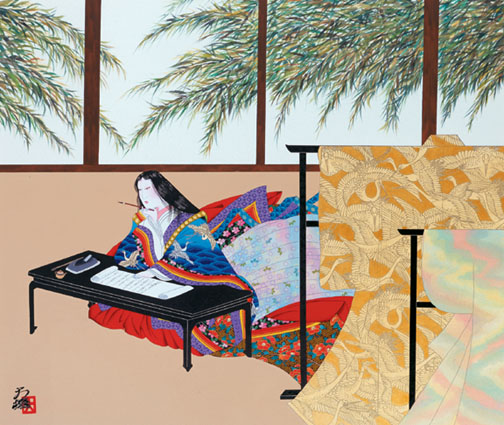My introduction to The Pillow Book was during the summer of 1997 when I returned to St.Louis from a year away in Vermont. I was 19 years old, just, and I was unfurling after a turbulent voyage. Not just the trip” home” through Appalachia with my dad, not just the years of an intense romance with chemicals and heightened reality, but adolescence in general. I was not yet exhausted, but I was on my way to becoming slightly less careless. This probably sounds messy and vague, but it all leads to the reason I have been enamored with the concept of the pillow book in the first place. I want to use this space to log my own catalog of ideas and experiences, kind of like a pillow book, but also not quite a pillowbook.
- because sometimes I forget things that I think I’d actually prefer to remember
- because I find it comforting to log ideas and look back at them later
- because I hope others will add to my lists and narrative with their own thoughts and create a web of sorts
- because I want to continue to explore the genre of the pillowbook and make a sort of map out of the adventure here.
That summer was a growing, shedding, re-birthing kind of summer. I had started to notice patterns in the things I was drawn to- a coherence in my thoughts and ideas was beginning to emerge. I had always been passionate about words, but had lacked the self discipline to harness the images in my mind and put them into language that did them justice. I ravaged books, music, experiences, people…I digested them all and forget them promptly, only to have them emerge in my thoughts, disjointed and dismembered. Some days I would think to myself, “I want to remember these things, I want to capture them!” I journaled, I wrote, but not with the skill or regularity that I felt my ideas deserved. I never carried a camera, I relished the moment. Other days I thought, this is the ultimate luxury, the most selfish and tantalizing thing a human can do- to live something and not write it down, not photograph it, so that it lingers only as an essence. I vacillated between the two ideologies. I collected bits and pieces of my day to day, and left entire chunks to my own memory alone, growing dust, slipping between the cracks, sometimes pressed up against the drywall of my mind with the double-stick tape of telling after retelling. I know I’m not alone is this feeling– about the idiosyncrasy of writing for one’s self…

One day I picked up a RiverFrontTimes, or some other free StL weekly and found a review of Peter Greenway’s upcoming release, The Pillow Book. Whether I had heard of a pillow book before this is a mystery to me, lost on one of those mental postits that did not stick so well. The movie itself (and the many interlaced encounters with Pillowbooks yet to come) were something that has created their own groove in my brain. That groove didn’t have to stick, it became such a part of me, I couldn’t erase it if I chose to. In conversations with friends over the years I noticed some people found similar connections to the tattoos they chose or the places they traveled to. These things meant something to them that they wanted to honor, or at least refused to ignore.
This is a rendering of Sei Shonagon, the Japanese courtisan who is beleived to have lived from 966-1017 and who is author of The Pillow Book that most people refer to when they mention a pillow book of any sort. Generally a pillow book has been described to me as a book of lists, but I realize now that it is more than that.
At first, Shonagon’s book of lists, reflections, descriptions of encounters and whatnot appealed to me because it was fascinating to see what she chose to write about. I feel the same infectious (and sometimes embarrassing) draw to spaces that focus on beauty, ritual behavior and adornment nowadays, I just tend not to admit to that out loud in certain circles!
As I became more practiced at my own personal writing, and began to take time with books that I read, discovering the connections they had to other works and their authors’ lived experiences, I began to notice the culture surrounding the writings in The Pillowbook. To open this up to you, I’ll just give you an example from the version I’ve read:
[From a list of “things that give you pleasure”:]
You’ve read the first volume of a tale you hadn’t come across before, and are longing to go on with it — then you find the other volume. The rest of it can sometimes turn out to be disappointing, however….
It’s also wonderfully pleasing when you’re in a large company of people in the presence of someone great, and she’s talking, either about something in the past or on a matter she’s only just heard about, some topic of the moment, and as she speaks, it’s you she singles out to look at…..
When a poem that you’ve composed for some event, or in a exchange of poems, is talked of by everyone and noted down when they hear it. This hasn’t happened to me personally, but I can imagine how it would feel….
When someone you don’t like meets with some misfortune, you’re pleased even though you know this is wicked of you. [McKinney, pp. 210-12]
At first, I felt far to dumb to critique Shonagon’s topics, after all- she was ancient. And translated. I think a lot of people, scholars included, do get blinded by the space between themself and a very aged work sometimes. At first, I definitely felt like I could only read her writing, that I simply didn’t know enough to engage with it. With time, I realized that this more than any other text was so much like my own running mental dialogue that I would be crazy not to get closer to it and interact with it.
Eventually I realized that just having a mental pillowbook in my own mind wasn’t enough. Still working on disciplined personal writing though, I hadn’t done anything more than read McKinney’s translation of the classic text. Then I wandered into my second favorite bookstore (this is my FAVORITE one.) I picked up a book by Whitney Otto titled A Collection of Beauties at the Height of Their Popularity. In this book, The Pillowbook resurfaces and the Otto showed me how a modern interpretation of the genre connected to the way I saw the world- constantly overlapping, but often confusing- like a patchwork quilt made of pieces of every dress you ever owned. My own daydreams and fixations on the seemingly frivolous things that make life enjoyable were echoed in this novel and it also touched some deep and disturbing chords. I LOVED it. I read and re-read it for about a year. I gave copies away to friends. I felt like it captured early adulthood in pillowbook format beautifully.

